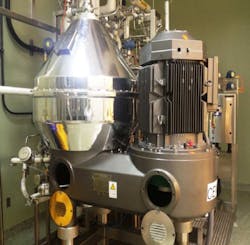Centrifuges are critical pieces of separation equipment in many biotech processes, but high vibration can limit their availability and cause stoppages in production. Vibration can stem from a variety of issues like imbalances, misalignment or damaged bearings.
Theoretically, the more preventive maintenance (PM) you perform, the better your equipment (including centrifuges and bearings) will be maintained. However, in reality, time-based PMs performed at regular intervals can actually do more harm than good in some cases. “A lot of companies are moving toward a reliability strategy that determines, ‘What maintenance do I need to do to help my equipment last the longest?’” explained Kristin Scharf, reliability technology consultant at New England Controls, during a presentation at the Emerson Global Users Exchange this week in Denver.
Scharf advocates that companies employ a condition-based maintenance plan (as opposed to time-based) to maximize the reliability of the centrifuge by touching it only when needed. Of course, in the life science industry, once a PM is set at a certain interval, it’s difficult to reduce the frequency—you have to have the proper justification data.
Condition monitoring
In one case, Bristol-Meyers Squibb (BMS) wanted to add condition monitoring to ensure centrifuge availability and change from time-based to condition-based maintenance to maximize reliability. A program to monitor vibration on a monthly basis was a challenge because of the limited, moving schedule of centrifugation runs. Continuous online monitoring was determined to be the best solution, and BMS selected Emerson Process Management’s CSI 9420 WirelessHART vibration transmitters. The system was appealing for a number of reasons:
- Low installation cost, including relatively low change control costs. They added transmitters (for the motor and cent bowl) near the centrifuge and ran a few cables to accelerometers mounted to motor inboard and outboard bearings, as well as axial and radial bearings. The solution did not require new infrastructure in the suite itself.
- Easy integration into the site’s DeltaV/AMS Device Manager automation network for alert monitoring.
- Ability to use the site’s existing AMS Machinery Manager software for online trending and vibration analysis. Further analysis via spectrum and waveform is collected when an alert is received to help determine the root cause of an excursion.
Condition monitoring with AMS Alert Monitor allows the user to view alerts prioritized according to the nature of the diagnostic and the importance of the device. Though training is needed to perform true vibration analysis, the reliability engineer on-site can view vibration data by looking at vibration parameters (energy bands) to help narrow down potential root causes. Companies can reach out to New England Controls, a local business partner for Emerson Process Management, when an alert occurs so that certified vibration technicians can determine the root cause of the issue.
Tips from Scharf:
- The noise threshold can be configured to help save battery life, so that analytical data is not collected when the equipment is not running.
- “Enable Store on Alert” can be used to increase power module life and to collect data at the most important time (this can be triggered immediately or collection can wait for a set time period if short duration spikes are prevalent).
Because the cost of lost production time greatly exceeds the cost of the WirelessHART network and vibration monitoring system, the return on investment is immediate. Additionally, companies using the system can save money by eliminating unnecessary bearing PMs that include maintenance, stocking and replacement of expensive (unworn) bearings.
About the Author

Leaders relevant to this article:
